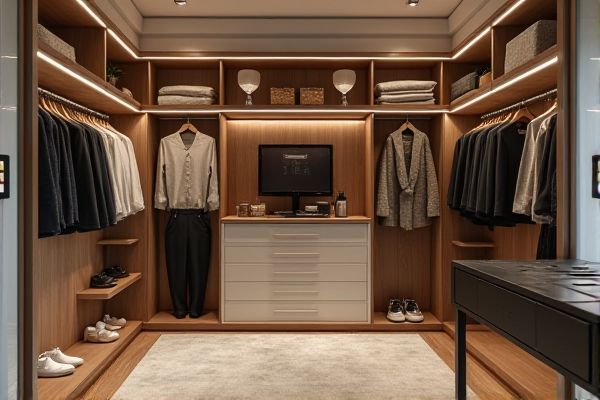
A closet valet and a closet butler both serve to organize and manage your clothing, but a closet valet typically refers to a compact, portable stand for hanging outfits, while a closet butler often implies a more extensive, built-in storage system or service. Explore the article to discover which option best suits your lifestyle and wardrobe needs.
Table of Comparison
| Feature | Closet Valet | Closet Butler |
|---|---|---|
| Purpose | Organizes clothes and accessories for daily use | Provides comprehensive wardrobe management and garment care |
| Functionality | Holds suits, shirts, pants, ties temporarily | Includes steaming, ironing, and occasional repair services |
| Design | Simple hanger-based frame or stand | Advanced setup with storage, hanging space, and care tools |
| Material | Wood, metal, or plastic | Premium wood and integrated hardware |
| Use Case | Ideal for daily outfit preparation | Best for managing entire wardrobes and garment upkeep |
| Price Range | $50-$200 | $500-$2000+ |
Closet Valet vs Closet Butler: Key Differences
Closet valet and closet butler systems both serve to organize and store clothing, but key differences lie in their design and functionality. A closet valet typically includes a valet rod, shelves, and trays designed for easy outfit preparation and daily use, while a closet butler offers more comprehensive storage options with features like drawers, shoe racks, and multiple hanging zones for a complete wardrobe solution. Your choice depends on whether you need a simple outfit organizer or a full-service closet system to maximize space and efficiency.
Defining the Closet Valet
The Closet Valet is a versatile organizational tool designed to streamline your wardrobe management, featuring compartments and hooks for clothing, accessories, and shoes. Unlike a Closet Butler, which primarily serves as a valet stand for hanging and preparing outfits, the Closet Valet integrates storage solutions to maximize space efficiency. Your closet becomes more functional and stylish by incorporating the Closet Valet's multi-purpose design.
What is a Closet Butler?
A Closet Butler is a specialized wardrobe organizer designed to streamline outfit selection by providing a retractable valet rod that extends from inside a closet. Unlike traditional closet valets that are standalone pieces, a Closet Butler integrates directly within the closet system, maximizing space efficiency and accessibility. This innovative solution supports the organization of clothes, accessories, and shoes, enhancing both convenience and closet functionality.
Design and Functionality Comparison
Closet valet systems prioritize compact design and versatility, often featuring movable hangers, adjustable rods, and integrated drawers for efficient garment storage and organization. Closet butlers emphasize a more substantial build with fixed racks, shelves, and sometimes seating, designed to facilitate outfit preparation and garment steaming or pressing. Both enhance closet functionality, but valet systems cater to flexible space utilization, while butlers focus on comprehensive wardrobe management and garment care.
Space Efficiency: Valet vs Butler
Closet valets maximize space efficiency by offering compact, multi-functional storage solutions, often including hooks, trays, and hangers designed for daily outfit organization. Closet butlers, while also enhancing storage, typically provide more expansive and customizable compartments tailored for larger wardrobes and formal wear. Valets suit smaller spaces with their streamlined design, whereas butlers optimize larger closets by integrating versatile storage zones.
Ease of Installation and Maintenance
Closet valets typically offer straightforward installation due to their minimal mounting requirements, often involving simple wall hooks or stands, which reduces setup time and complexity. Closet butlers, equipped with more advanced features such as adjustable arms and integrated storage compartments, may demand professional installation and periodic maintenance to ensure smooth operation. Choosing between the two depends on the user's preference for quick setup and low upkeep versus enhanced functionality and durability.
Material Quality and Durability
Closet valet systems often feature high-grade wood or metal frames designed for durability and luxury, ensuring long-lasting performance in organizing your wardrobe. Closet butlers typically incorporate materials like stainless steel or sturdy plastic, prioritizing lightweight convenience with solid construction for everyday use. Choosing the right option depends on your preference for material quality and how much durability you need in your closet management solution.
Cost Analysis: Which is More Affordable?
Closet valets generally offer a more affordable option compared to closet butlers due to their simpler design and fewer features, making them ideal for budget-conscious buyers. Closet butlers often include added functionalities such as built-in drawers, lighting, and electronic components, which increase both their initial cost and potential maintenance expenses. Your choice depends on whether you prioritize advanced features and customization or prefer a cost-effective solution for organizing your closet space.
Style and Customization Options
Closet valets offer sleek, minimalist designs with modular components that allow personalized arrangement of hangers, shelves, and drawers to suit specific storage needs. Closet butlers emphasize classic craftsmanship with customizable wood finishes, intricate detailing, and built-in compartments for accessories, blending functionality with artisanal style. Both options enable tailored organization but differ in aesthetic focus, catering to modern minimalism versus traditional elegance.
Which Option is Best for Your Closet Needs?
A closet valet offers a compact, portable solution ideal for temporary garment organization and outfit planning, featuring hangers, trays, and sometimes mirrors. In contrast, a closet butler is a more elaborate, often fixed unit designed for long-term wardrobe management with multiple compartments, adjustable rods, and storage drawers. Choosing between them depends on your space, frequency of use, and whether you prioritize mobility or comprehensive closet organization.
 homyna.com
homyna.com